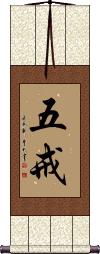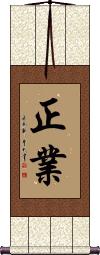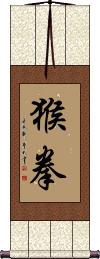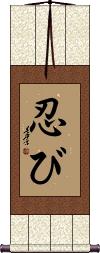Many custom options...
And formats...

Stealing in Chinese / Japanese...
Buy a Stealing calligraphy wall scroll here!
Personalize your custom “Stealing” project by clicking the button next to your favorite “Stealing” title below...
Monkey Stealing Peaches
Martial arts term
猴子偷桃 is a martial arts term that I find hilarious. I thought Stephen Chow had made this up for his Monkey King movie. After some research, it turns out to be real.
This can be translated as “monkey stealing peaches” or “monkey steals the peach.” It refers to distracting an opponent with one hand and seizing his testicles with the other.
In colloquial Chinese speech, this can refer to grabbing somebody by the balls (without any martial arts technique to the grabbing).
Five Precepts
五戒 is the title or name for the five precepts of Buddhism.
These are prohibitions against killing, theft, sexual misconduct, lying, and intoxication.
Also phrased as commandments against murder, stealing, adultery, false speech, and consuming intoxicating liquors.
These five precepts or “pañca-veramaṇī” apply to the Buddhist laity as well as monks and nuns. The observance of these five ensures rebirth in the human realm.
4. Right Action / Perfect Conduct
Samyak Karmanta / Samma Kammanta
正業 is one of the Noble Eightfold Paths of Buddhism. Right Action, along with Right Speech and Right Living, constitute the path to Virtue.
The five precepts of Right Action are...
1. Refrain from destroying living beings (no murder or any form of taking a life).
2. Refrain from stealing.
3. Refrain from sexual misconduct (adultery, rape, etc.).
4. Refrain from false speech (lying or trickery).
5. Refrain from intoxicants that lead to heedlessness (no drugs or alcohol).
This concept can be summarized as “Avoidance of actions that conflict with moral discipline.”
Note: In Japanese, when read by a non-Buddhist, this will mean “the right job/vocation.”
This term is exclusively used by devout Buddhists. It is not a common term, and is remains an unknown concept to most Japanese and Chinese people.
See Also: Buddhism | Enlightenment | Noble Eightfold Path
Monkey Fist
猴拳 literally means what you think, it's the “Monkey Fist” school of Kung Fu. A style that mimics the punches and movements of monkeys and apes.
Becoming popular during the Qing Dynasty, this style can trace its origins back to as early as the Song Dynasty. Some of the romance and popularity of this style comes from the novel “Journey to the West” which features the Monkey King and his fighting skills.
This novel and martial arts style has spawned a stream of Hong Kong movies featuring the Monkey King and other Kung Fu style variations such as “Drunken Monkey” and “Monkey Stealing Peaches” (a technique of disabling your opponent by grabbing and yanking on his testicles).
Note: This kind of makes sense in Korean Hanja and Japanese Kanji but probably unknown by all Koreans and Japanese except those who have an interest in this form of Kung Fu.
Shinobi / Ninja Outcast
忍び (Shinobi) is a term often associated with ninjas of ancient Japan.
忍び really means stealing (into), a spy, a sneaking thief, stealth, or a surreptitious visit to a house of ill repute. However, 忍び is sometimes used to refer to an outcast ninja.
This term was somehow given a better report when various video games, TV series, and even a movie came out with this Shinobi title.
忍び are sometimes Romanized as two words: Shin obi or Shin-obi.
Note: The first character can be written as  or
or ![]() .
.
Not the results for stealing that you were looking for?
Below are some entries from our dictionary that may match your stealing search...
| Characters If shown, 2nd row is Simp. Chinese |
Pronunciation Romanization |
Simple Dictionary Definition |
五戒 see styles |
wǔ jiè wu3 jie4 wu chieh gokai ごかい |
More info & calligraphy: Five Preceptspañca-veramaṇī; the first five of the ten commandments, against killing, stealing, adultery, lying, and intoxicating liquors. 不殺生; 不偸盜; 不邪婬; 不妄語; 不飮酒 They are binding on laity, male and female, as well as on monks and nuns. The observance of these five ensures rebirth in the human realm. Each command has five spirits to guard its observer 五戒二十五神. |
三盗 see styles |
santou / santo さんとう |
{baseb} stealing third base |
三福 see styles |
sān fú san1 fu2 san fu mifuku みふく |
(place-name, surname) Mifuku The three (sources of) felicity: (1) The 無量壽經 has the felicity of (a) 世福 filial piety, regard for elders, keeping the ten commandments; (b) 戒福 of keeping the other commandments; (c) 行福 of resolve on complete bodhi and the pursuit of the Buddha-way. (2) The 倶舍論 18, has the blessedness of (a) 施類福 almsgiving, in evoking resultant wealth; (b) 戒類福 observance of the 性戒 (against killing, stealing, adultery, lying) and the 遮戒 (against alcohol, etc.), in obtaining a happy lot in the heavens; (c) 修類福 observance of meditation in obtaining final escape from the mortal round. Cf. 三種淨業. |
不盜 不盗 see styles |
bù dào bu4 dao4 pu tao futō |
not stealing |
二盗 see styles |
nitou / nito にとう |
(n,vs,vi) {baseb} stealing second base |
五惡 五恶 see styles |
wǔ è wu3 e4 wu o goaku |
The five sins— killing, stealing, adultery, lying, drinking intoxicants. Cf. 五戒. |
五逆 see styles |
wǔ nì wu3 ni4 wu ni gogyaku ごぎゃく |
(1) {Buddh} five cardinal sins (killing one's father, killing one's mother, killing an arhat, shedding the blood of a Buddha, causing a schism within the sangha); (2) (hist) crime of killing one's master, father, grandfather, mother, or grandmother pañcānantarya; 五無間業 The five rebellious acts or deadly sins, parricide, matricide, killing an arhat, shedding the blood of a Buddha, destroying the harmony of the sangha, or fraternity. The above definition is common both to Hīnayāna and Mahāyāna. The lightest of these sins is the first; the heaviest the last. II. Another group is: (1) sacrilege, such as destroying temples, burning sutras, stealing a Buddha's or a monk's things, inducing others to do so, or taking pleasure therein; (2) slander, or abuse of the teaching of śrāvaka s, pratyekabuddhas, or bodhisattvas; (3) ill-treatment or killing of a monk; (4) any one of the five deadly sins given above; (5) denial of the karma consequences of ill deeds, acting or teaching others accordingly, and unceasing evil life. III. There are also five deadly sins, each of which is equal to each of the first set of five: (1) violation of a mother, or a fully ordained nun; (2) killing a bodhisattva in a sangha; (5) destroying a Buddha's stūpa. IV. The five unpardonable sin of Devadatta who (1) destroyed the harmony of the community; (2) injured Śākyamuni with a stone, shedding his blood; (3) induced the king to let loose a rutting elephant to trample down Śākyamuni; (4) killed a nun; (5) put poison on his finger-nails and saluted Śākyamuni intending to destroy him thereby. |
偸盜 偸盗 see styles |
tōu dào tou1 dao4 t`ou tao tou tao tōtō |
Steal, rob; one of the ten sins. |
十惡 十恶 see styles |
shí è shi2 e4 shih o jūaku |
Daśākuśala. The ten "not right" or evil things are killing, stealing, adultery, lying, double-tongue, coarse language, filthy language, covetousness, anger, perverted views; these produce the ten resultant evils 十惡業 (道) Cf. 十善; 十戒. |
呪盜 呪盗 see styles |
zhòu dào zhou4 dao4 chou tao jutō |
stealing through charms, spells, etc. |
四墮 四堕 see styles |
sì duò si4 duo4 ssu to shida |
(四墮落法) The four causes of falling from grace and final excommunication of a monk or nun; adultery, stealing, killing, falsity; v. 四波羅夷. |
四重 see styles |
sì zhòng si4 zhong4 ssu chung shijuu / shiju しじゅう |
(noun - becomes adjective with の) fourfold (四重禁) The four grave prohibitions, or sins, 四重罪 pārājikas: killing, stealing, carnality, lying. Also four of the esoteric sect, i. e. discarding the truth, discarding the bodhi-mind, being mean or selfish in regard to the supreme law, injuring the living. |
失敬 see styles |
shī jìng shi1 jing4 shih ching shikkei / shikke しっけい |
to show disrespect; I'm awfully sorry – please forgive me (n,vs,adj-na) (1) rudeness; impoliteness; disrespect; impertinence; (noun/participle) (2) (masculine speech) leaving; going (on one's way); saying goodbye; (noun/participle) (3) taking without permission; stealing; pinching; pilfering; (interjection) (4) (masculine speech) my apologies; I must be going now; so long |
女賊 女贼 see styles |
nǚ zéi nv3 zei2 nü tsei jozoku; nyozoku じょぞく; にょぞく |
(1) (hist) female bandit; female robber; (2) (にょぞく only) (derogatory term) {Buddh} woman (who distracts men's search for truth) Woman the robber, as the cause of sexual passion, stealing away the riches of religion, v. 智度論 14. |
婚い see styles |
yobai よばい |
(noun/participle) creeping at night into a woman's bedroom; stealing into a girl's bedroom at night to make love; sneaking visit |
本盗 see styles |
hontou / honto ほんとう |
{baseb} (See ホームスチール) stealing home |
猫糞 see styles |
nekobaba ねこばば |
(noun/participle) (kana only) embezzlement; misappropriation; pocketing; stealing |
癟三 瘪三 see styles |
biē sān bie1 san1 pieh san |
(Wu dialect) bum; wretched-looking tramp who lives by begging or stealing |
盗み see styles |
nusumi ぬすみ |
stealing; theft |
盗塁 see styles |
tourui / torui とうるい |
(n,vs,vi) {baseb} base stealing; steal; stolen base |
盗掠 see styles |
touryaku / toryaku とうりゃく |
(noun, transitive verb) (rare) stealing; looting; plundering |
盗電 see styles |
touden / toden とうでん |
(n,vs,vi) stealing electricity |
盜戒 盗戒 see styles |
dào jiè dao4 jie4 tao chieh tōkai |
precepts regarding stealing |
盜罪 盗罪 see styles |
dào zuì dao4 zui4 tao tsui tōzai |
the crime of stealing |
磨灑 磨洒 see styles |
mó sǎ mo2 sa3 mo sa masai |
摩沙 māṣa, a bean, also a weight of gold valued at 80 Chinese cash; the stealing of goods to the value of 5 māṣa involved expulsion from the monkhood, as also in India it is said to have involved exile. |
窃取 see styles |
sesshu せっしゅ |
(noun, transitive verb) theft; stealing; larceny |
窃盗 see styles |
settou / setto せっとう |
(n,vs,vt,adj-no) theft; stealing; larceny |
邊罪 边罪 see styles |
biān zuì bian1 zui4 pien tsui henzai |
Sins of expulsion from the order, i.e. sexual intercourse, killing, stealing, lying. |
不偸盜 不偸盗 see styles |
bù tōu dào bu4 tou1 dao4 pu t`ou tao pu tou tao fu chūtō |
adinnādāna-veramaṇī; the second of the ten commandments, Thou shalt not steal. |
不盜戒 不盗戒 see styles |
bù dào jiè bu4 dao4 jie4 pu tao chieh futō kai |
injunctions against stealing |
Click here for more stealing results from our dictionary
The following table may be helpful for those studying Chinese or Japanese...
| Title | Characters | Romaji (Romanized Japanese) | Various forms of Romanized Chinese | |
| Monkey Stealing Peaches | 猴子偷桃 | hóu zi tōu táo hou2 zi5 tou1 tao2 hou zi tou tao houzitoutao | hou tzu t`ou t`ao houtzutoutao hou tzu tou tao |
|
| Five Precepts | 五戒 | go kai / gokai | wǔ jiè / wu3 jie4 / wu jie / wujie | wu chieh / wuchieh |
| 4. Right Action Perfect Conduct | 正業 正业 | sei gyou / seigyou / sei gyo | zhèng yè / zheng4 ye4 / zheng ye / zhengye | cheng yeh / chengyeh |
| Monkey Fist | 猴拳 | hóu quán / hou2 quan2 / hou quan / houquan | hou ch`üan / houchüan / hou chüan | |
| Shinobi Ninja Outcast | 忍び | shino-bi | ||
| In some entries above you will see that characters have different versions above and below a line. In these cases, the characters above the line are Traditional Chinese, while the ones below are Simplified Chinese. | ||||
Successful Chinese Character and Japanese Kanji calligraphy searches within the last few hours...








